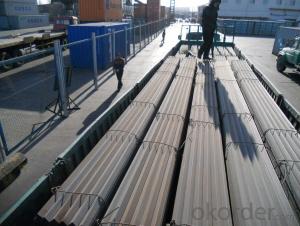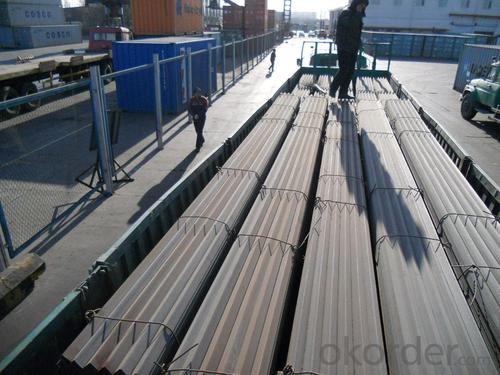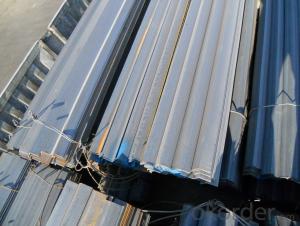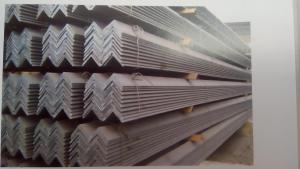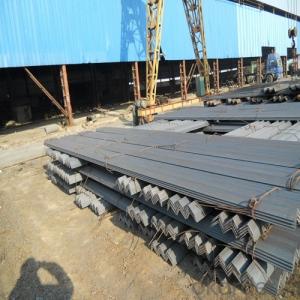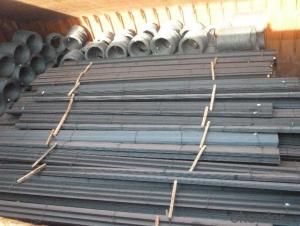Hot Rolled Steel Equal Angle Bar Unequal Angle Bar JIS GB EN DIN ASTM
- Loading Port:
- Tianjin
- Payment Terms:
- TT OR LC
- Min Order Qty:
- 25 m.t.
- Supply Capability:
- 30000 m.t./month
OKorder Service Pledge
OKorder Financial Service
You Might Also Like
Specification
Product Description:
OKorder is offering Hot Rolled Steel Equal Angle Bar Unequal Angle Bar JIS GB EN DIN ASTM at great prices with worldwide shipping. Our supplier is a world-class manufacturer of steel, with our products utilized the world over. OKorder annually supplies products to European, North American and Asian markets. We provide quotations within 24 hours of receiving an inquiry and guarantee competitive prices.
Product Applications:
Hot Rolled Steel Equal Angle Bar Unequal Angle Bar JIS GB EN DIN ASTM are ideal for structural applications and are widely used in the construction of buildings and bridges, and the manufacturing, petrochemical, and transportation industries.
Product Advantages:
OKorder's Hot Rolled Steel Equal Angle Bar Unequal Angle Bar JIS GB EN DIN ASTM are durable, strong, and resist corrosion.
Main Product Features:
· Premium quality
· Prompt delivery & seaworthy packing (30 days after receiving deposit)
· Corrosion resistance
· Can be recycled and reused
· Mill test certification
· Professional Service
· Competitive pricing
Product Specifications:
Specifications of Angle Steel
1. Invoicing on theoretical weight or actual weight as customer request
2. Length: 6m, 9m, 12m as following table
3. Sizes
Sizes: 25mm-250mm | ||
a*t | ||
25*2.5-4.0 | 70*6.0-9.0 | 130*9.0-15 |
30*2.5-6.6 | 75*6.0-9.0 | 140*10-14 |
36*3.0-5.0 | 80*5.0-10 | 150*10-20 |
38*2.3-6.0 | 90*7.0-10 | 160*10-16 |
40*3.0-5.0 | 100*6.0-12 | 175*12-15 |
45*4.0-6.0 | 110*8.0-10 | 180*12-18 |
50*4.0-6.0 | 120*6.0-15 | 200*14-25 |
60*4.0-8.0 | 125*8.0-14 | 250*25 |
Angle specifications with the side length of the size and edge thickness. At present, the domestic steel specifications for 2 - 20 cm in length, number of numbers, the same horn steel often have 2 - 7 different edge thickness. The actual size and inlet angle marked on both sides of the thickness and indicate the relevant standards. The general length of more than 312.5px for large angle steel, 312.5px - 125px for the medium angle, length of 125px for smallangle.
Inlet and outlet angle steel orders generally required the use specifications in the steel,carbon structural steel grades as appropriate. Is the angle in addition to standard number, nospecific composition and performance series.
Angle steel delivery length is divided into fixed length, size two, domestic steel length range is3 - 9m, 4 12M, 4 19m, 6 19m four range according to different specifications. Japanese steellength ranges from 6 to 15m.
Section of unequal angle height according to the long edge of the width to calculate the non equilateral angle steel. Refer to section angle and side length is not equal to the steel. Is a kind of angle steel. The length from 25mm * 16mm to 200mm * l25mm. By the hot rolling mill rolling in. General scalene angle steel specifications: thickness of 4-18mm / 50*32-- / 200*125
Equilateral angle steel is widely used in all kinds of metal structures, bridges, machinery manufacturing and shipbuilding industry, all kinds of architectural and engineering structures,such as beams, bridges, towers, hoisting and conveying machinery, ships, industrial furnace,reactor, container frame and warehouse etc.
FAQ:
Q1: Why buy Materials & Equipment from OKorder.com?
A1: All products offered byOKorder.com are carefully selected from China's most reliable manufacturing enterprises. Through its ISO certifications, OKorder.com adheres to the highest standards and a commitment to supply chain safety and customer satisfaction.
Q2: How do we guarantee the quality of our products?
A2: We have established an advanced quality management system which conducts strict quality tests at every step, from raw materials to the final product. At the same time, we provide extensive follow-up service assurances as required.
Q3: How soon can we receive the product after purchase?
A3: Within three days of placing an order, we will begin production. The specific shipping date is dependent upon international and government factors, but is typically 7 to 10 workdays.
Q4: What makes stainless steel stainless?
A4: Stainless steel must contain at least 10.5 % chromium. It is this element that reacts with the oxygen in the air to form a complex chrome-oxide surface layer that is invisible but strong enough to prevent further oxygen from "staining" (rusting) the surface. Higher levels of chromium and the addition of other alloying elements such as nickel and molybdenum enhance this surface layer and improve the corrosion resistance of the stainless material.
Q5: Can stainless steel rust?
A5: Stainless does not "rust" as you think of regular steel rusting with a red oxide on the surface that flakes off. If you see red rust it is probably due to some iron particles that have contaminated the surface of the stainless steel and it is these iron particles that are rusting. Look at the source of the rusting and see if you can remove it from the surface.
Images:
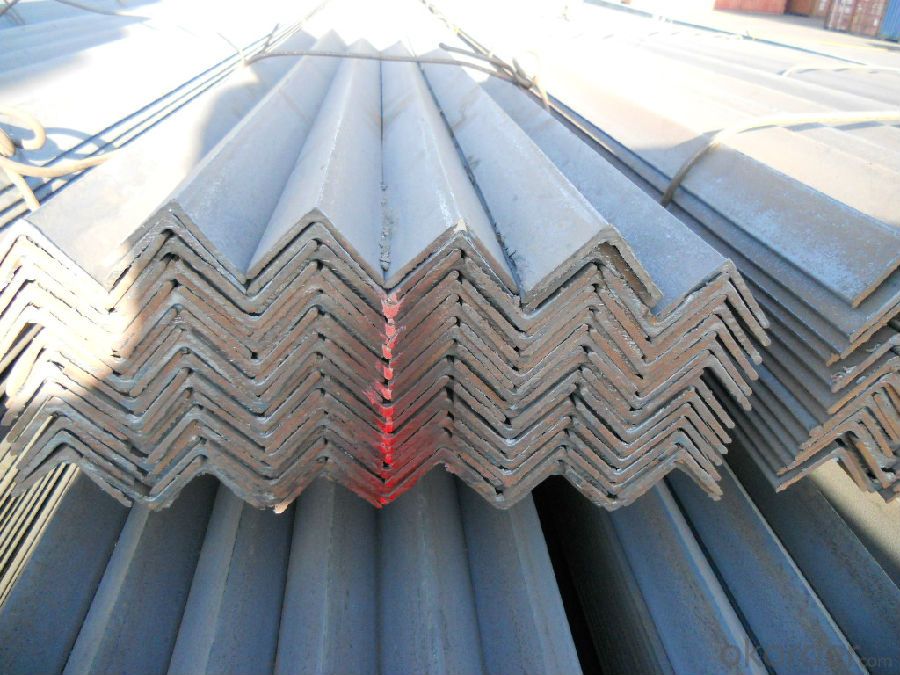
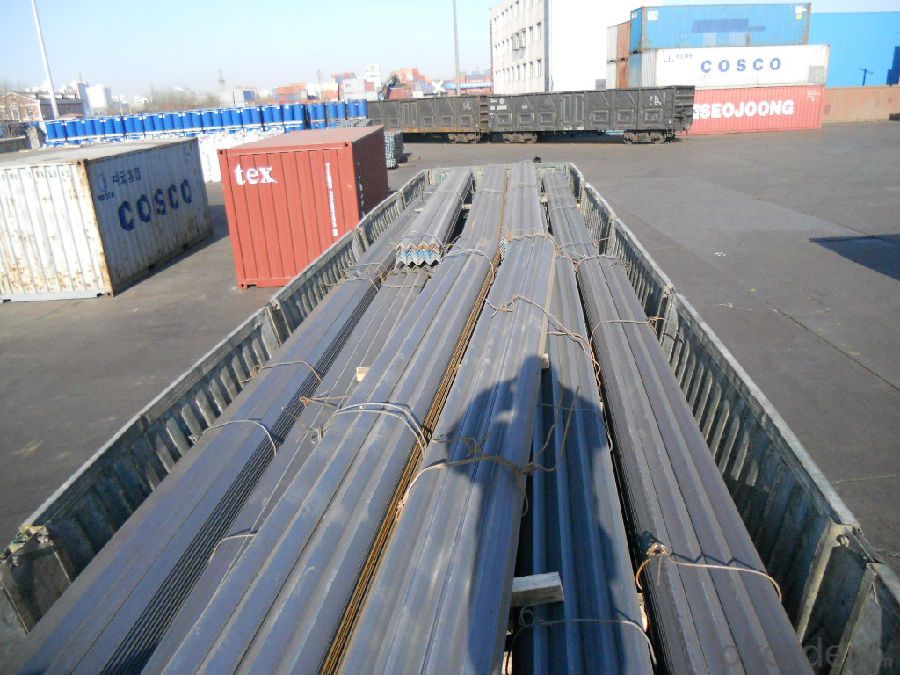
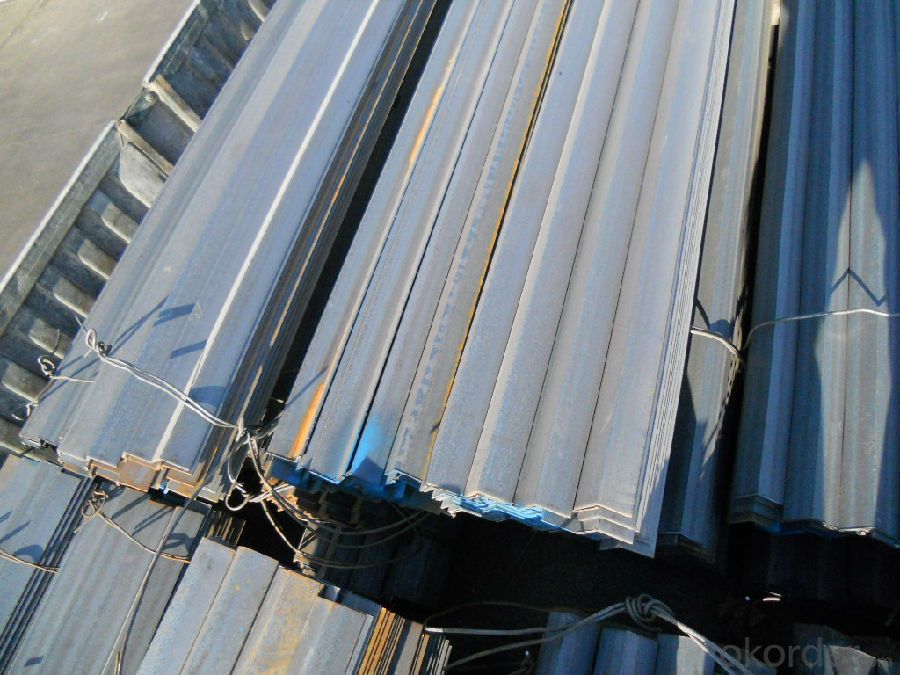
- Q: What are the different tolerances for steel angles?
- The different tolerances for steel angles can vary depending on the specific industry standards and requirements. Generally, tolerances for steel angles may include measurements for dimensions such as length, width, thickness, and straightness. These tolerances ensure that the steel angles meet the desired specifications and can be properly utilized in various applications.
- Q: What are the limitations of using steel angles in high-temperature applications?
- One limitation of using steel angles in high-temperature applications is that steel has a relatively low melting point compared to other materials like refractory metals or ceramics. At high temperatures, steel can start to deform, lose its strength, and even melt, leading to structural failures. Additionally, steel can undergo significant thermal expansion and contraction, which can cause dimensional changes and potential cracking in the angles. Therefore, alternative materials with higher melting points and better resistance to thermal expansion may be more suitable for high-temperature applications.
- Q: Can steel angles be used for manufacturing storage racks?
- Indeed, storage racks can be manufactured using steel angles. With their versatility and strength, steel angles prove to be an optimal option for the construction of such racks. By providing stability and structural integrity, they guarantee the capability to bear substantial loads. Moreover, steel angles allow for the seamless welding or bolting together, enabling the production of tailor-made racks that satisfy specific storage needs. The longevity of steel angles further assures the endurance of the storage racks against gradual deterioration. As a result, steel angles find widespread application in the manufacturing of storage racks across diverse industries encompassing warehousing, retail, and logistics.
- Q: How do you calculate the axial load capacity of a steel angle?
- To calculate the axial load capacity of a steel angle, you need to consider several factors including the material properties of the angle, its dimensions, the type of loading, and the safety factor. First, you should determine the yield strength of the steel angle. This value represents the maximum stress the angle can withstand without permanent deformation. The yield strength can be obtained from the steel angle's specifications or by conducting material testing. Next, you need to measure the dimensions of the angle, including its length, thickness, and width. These values are crucial in determining the area of the cross-section of the angle. Once you have the yield strength and the cross-sectional area, you can calculate the axial load capacity using the formula: Axial load capacity = Yield strength × Cross-sectional area It is important to note that this formula assumes that the angle is subjected to direct axial loading. If the angle is subjected to combined loading or other complex loading conditions, additional calculations or structural analysis may be required. Moreover, it is customary to apply a safety factor to the calculated axial load capacity to account for uncertainties and ensure structural integrity. The safety factor is typically determined based on the specific application and industry standards. For example, a safety factor of 1.5 is commonly used in structural design. In summary, to calculate the axial load capacity of a steel angle, you need to know its yield strength, measure its dimensions, and apply the appropriate safety factor. This calculation provides an estimate of the maximum load the angle can bear without failure under axial loading conditions.
- Q: What are the different standards and specifications for steel angles?
- There are several different standards and specifications for steel angles, which determine the physical and mechanical properties of the angles. Some of the most commonly used standards include: 1. ASTM A36/A36M: This is a standard specification for carbon structural steel, including angles. It specifies the chemical composition, mechanical properties, and other requirements for carbon steel angles. 2. ASTM A529/A529M: This specification covers high-strength carbon-manganese steel shapes, including angles. It outlines the composition, mechanical properties, and other specifications for these angles. 3. ASTM A572/A572M: This standard specification covers high-strength low-alloy columbium-vanadium structural steel shapes, including angles. It provides details on the chemical composition, mechanical properties, and other requirements for these angles. 4. ASTM A588/A588M: This specification covers high-strength low-alloy structural steel shapes, including angles, with improved atmospheric corrosion resistance. It specifies the chemical composition, mechanical properties, and other characteristics for these angles. 5. ASTM A709/A709M: This standard specification covers carbon and high-strength low-alloy structural steel shapes, including angles, for use in bridges. It provides information on the chemical composition, mechanical properties, and other specifications for these angles. 6. EN 10056: This European standard specifies the tolerances on shape, dimensions, and mass of hot-rolled structural steel equal and unequal angles. It also provides information on the mechanical properties and other requirements for these angles. 7. JIS G3192: This Japanese standard specifies the dimensions, mass, and permissible variations of hot-rolled steel sections, including angles. It outlines the mechanical properties and other specifications for these angles. These are just a few examples of the different standards and specifications for steel angles. It is important to consult the specific standard relevant to your project or application to ensure that the steel angles meet the required criteria.
- Q: Do steel angles come with any warranties?
- Yes, steel angles typically come with warranties provided by the manufacturer or supplier. These warranties may vary in terms of duration and coverage, so it is important to check the specific warranty details offered by the supplier before making a purchase.
- Q: Are steel angles suitable for high-rise buildings?
- Yes, steel angles are suitable for high-rise buildings. They are commonly used as structural elements in high-rise construction due to their strength, durability, and ability to bear heavy loads. Steel angles provide stability and support to the building structure, making them an ideal choice for high-rise construction projects.
- Q: What are the different surface treatments for steel angles?
- There are several different surface treatments available for steel angles, each designed to enhance their durability, appearance, and resistance to corrosion. Some of the common surface treatments for steel angles include: 1. Hot-dip galvanizing: This process involves immersing the steel angles in a bath of molten zinc, which forms a protective coating on the surface. Galvanizing provides excellent corrosion resistance and is ideal for outdoor applications where the angles may be exposed to moisture and harsh weather conditions. 2. Powder coating: Powder coating involves applying a dry powder paint to the surface of the steel angles. The angles are then heated, causing the powder to melt and form a smooth, durable coating. Powder coating provides a wide range of color options and improves the angles' resistance to chipping, scratching, and fading. 3. Electroplating: Electroplating involves depositing a layer of metal onto the surface of the steel angles through an electrochemical process. Common metals used for electroplating include zinc, nickel, and chrome. Electroplating provides both aesthetic appeal and enhanced resistance to corrosion. 4. Priming and painting: Priming and painting involves applying a layer of primer followed by a coat of paint to the steel angles. Priming helps improve adhesion and provides a smooth surface for the paint to adhere to. Painting not only enhances the appearance of the angles but also provides some protection against corrosion. 5. Anodizing: Anodizing is typically used for aluminum angles rather than steel, but it can also be applied to steel. This process involves creating an oxide layer on the surface of the angles by subjecting them to an electrolytic process. Anodizing improves the angles' corrosion resistance, hardness, and color stability. It is important to choose the appropriate surface treatment for steel angles based on the specific application and environmental conditions they will be exposed to. Each treatment offers unique benefits in terms of corrosion resistance, aesthetics, and durability, so carefully considering these factors will help ensure the longevity and performance of the steel angles.
- Q: Can steel angles be used in railway infrastructure?
- Railway infrastructure can utilize steel angles. These L-shaped structural steel components, commonly referred to as steel angles, have a wide range of uses in the construction industry, including railway infrastructure. They are frequently employed in the creation of railway tracks, bridges, support structures, and other elements of the railway system. The reasons steel angles are favored in railway infrastructure are due to their exceptional strength, durability, and versatility. They are capable of withstanding heavy loads and providing excellent structural support, which makes them ideal for the demanding conditions of railway tracks and structures. Additionally, steel angles are resistant to corrosion, a crucial feature for railway infrastructure that is exposed to harsh environmental conditions. Within railway tracks, steel angles are often employed as base plates, connecting the rails to the sleepers or ties. Their use ensures stability and equal distribution of the load, thereby guaranteeing the safe and smooth operation of trains. Moreover, steel angles are utilized as the primary structural element for supporting the weight of trains in bridge construction. Furthermore, steel angles are easily fabricated and installed, making them a cost-effective choice for railway infrastructure projects. They can be cut, welded, and shaped to meet specific design requirements, enabling efficient construction and customization. In conclusion, steel angles have proven to be a dependable and efficient option for railway infrastructure. Their strength, durability, and versatility make them suitable for various applications within the railway system, thereby contributing to the safety and efficiency of train operations.
- Q: How do you determine the resistance to lateral-torsional buckling of a steel angle?
- To determine the resistance to lateral-torsional buckling of a steel angle, several factors need to be considered. The resistance to lateral-torsional buckling is primarily influenced by the geometric properties of the angle section, the material properties of the steel, and the boundary conditions of the member. 1. Geometric properties: The critical geometric properties that affect the resistance to lateral-torsional buckling are the length, width, thickness, and the slenderness ratio of the angle section. The slenderness ratio is the ratio of the length to the radius of gyration of the section and is a measure of the member's stability. Higher slenderness ratios indicate a higher susceptibility to lateral-torsional buckling. 2. Material properties: The resistance to lateral-torsional buckling also depends on the material properties of the steel angle, such as its yield strength, modulus of elasticity, and the shape of the stress-strain curve. These properties determine the capacity of the steel angle to withstand bending and twisting moments without buckling. 3. Boundary conditions: The boundary conditions of the steel angle, including the type of support and the loading conditions, significantly affect its resistance to lateral-torsional buckling. The type of support, such as simply supported or fixed, determines the degree of rotational and translational constraints on the member. Similarly, the applied loads, such as point loads, distributed loads, or moments, determine the bending and twisting moments acting on the angle section. To determine the resistance to lateral-torsional buckling, engineers usually refer to relevant design codes and standards, such as the American Institute of Steel Construction (AISC) Manual or Eurocode. These codes provide design formulas and tables that consider the geometric properties, material properties, and boundary conditions to calculate the critical moment and the corresponding resistance to lateral-torsional buckling for the steel angle. Additionally, finite element analysis (FEA) software or other advanced computer simulations can be employed to obtain more accurate results by considering complex loadings and boundary conditions.
Send your message to us
Hot Rolled Steel Equal Angle Bar Unequal Angle Bar JIS GB EN DIN ASTM
- Loading Port:
- Tianjin
- Payment Terms:
- TT OR LC
- Min Order Qty:
- 25 m.t.
- Supply Capability:
- 30000 m.t./month
OKorder Service Pledge
OKorder Financial Service
Similar products
Hot products
Hot Searches
Related keywords
